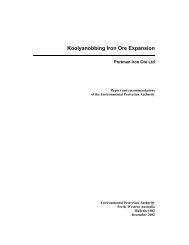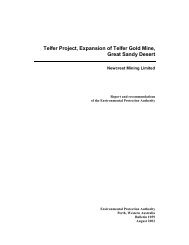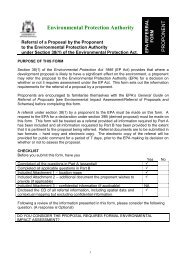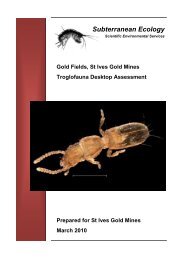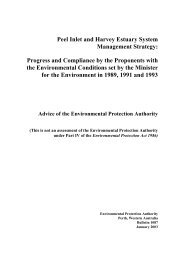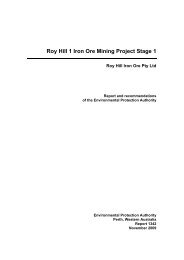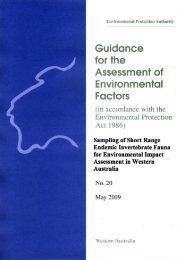Flora survey for Hamersley Drive recreation - Environmental ...
Flora survey for Hamersley Drive recreation - Environmental ...
Flora survey for Hamersley Drive recreation - Environmental ...
Create successful ePaper yourself
Turn your PDF publications into a flip-book with our unique Google optimized e-Paper software.
FRNP Improvement Project: Culham Inlet to <strong>Hamersley</strong> Inlet GF Craig– July 2010<br />
5. Requirement <strong>for</strong> Referral or Other Clearances<br />
DEC has ranked plant taxa considered to be threatened under a series of conservation<br />
codes, depending on their apparent degree of threat (see Appendix 1). Taxa listed as<br />
Declared Rare <strong>Flora</strong> require permission from the Minister responsible <strong>for</strong> the Wildlife<br />
Conservation Act 1950, if any portion of the plant is to be, or likely to be, disturbed.<br />
The <strong>Hamersley</strong> <strong>Drive</strong> upgrade will require permits to take Adenanthos ellipticus, Eucalyptus<br />
burdettiana, Eucalyptus coronata, Kunzea similis subsp. similis, Stylidium galioides and<br />
Verticordia pityrhops.<br />
Schedule 5 of the <strong>Environmental</strong> Protection Act 1986 has 10 principles of clearing. The<br />
wave-cut bench at the base of East Mt Barren, is one of the most botanically important sites<br />
in the FRNP and along the south coast. It is highly diverse with a large number of short-range<br />
endemics, including six species of Declared Rare flora two of which (K. similis and V.<br />
pityrhops) grow nowhere else. Also, a number of micro-wetlands supporting sedge<br />
communities important to fauna occur here (see Chapman 2009).<br />
According to Schedule 5, native vegetation should not be cleared if —<br />
1. it comprises a high level of biological diversity;<br />
2. it includes, or is necessary <strong>for</strong> the continued existence of, rare flora;<br />
3. it is growing in, or in association with, an environment associated with a watercourse<br />
or wetland;<br />
4. the clearing of the vegetation is likely to have an impact on the environmental values<br />
of any adjacent or nearby conservation area.<br />
According to the above criteria, none of the vegetation on the wave-cut bench should have<br />
any further disturbance.<br />
Concept plans <strong>for</strong> the <strong>recreation</strong>al nodes propose installation of new roads and carparks. As<br />
well, the intersection of <strong>Hamersley</strong> Road and <strong>Hamersley</strong> Inlet Road is proposed <strong>for</strong><br />
realignment. A number of these sites will require clearing of native vegetation of an area<br />
greater than one hectare. It is recommended that Main Roads WA determine the requirement<br />
to obtain a permit under the <strong>Environmental</strong> Protection (Clearing of Native Vegetation)<br />
Regulations 2004 from the Department of Environment and Conservation (DEC). Permit<br />
applications need to consider impacts including, but not restricted to: biodiversity, rare flora,<br />
threatened ecological communities and level of remnant vegetation representation (EPA<br />
2004).<br />
The Deputy Secretary of the Department of Environment, Water, Heritage and the Arts<br />
decided on 17 July 2010 that the FRNP Improvement Project is not a “controlled action” under<br />
the Commonwealth’s <strong>Environmental</strong> Protection and Biodiversity Conservation Act (EPBC<br />
Act). According to this decision, (i) DEC must adhere to a number of strict environment<br />
management protocols to mitigate any environmental impacts, and (ii) DEC has committed to<br />
mitigating any consequential and cumulative impacts from the development to ensure there is<br />
no significant impact upon an EPBC listed species in the future.<br />
25



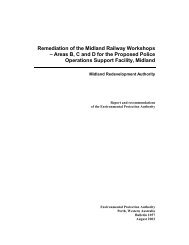
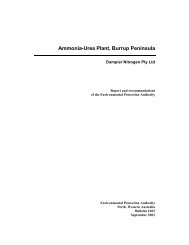
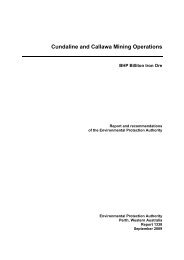
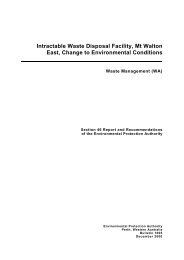
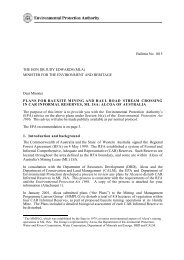
![[Project Title] - Environmental Protection Authority - The Western ...](https://img.yumpu.com/29001740/1/184x260/project-title-environmental-protection-authority-the-western-.jpg?quality=85)
